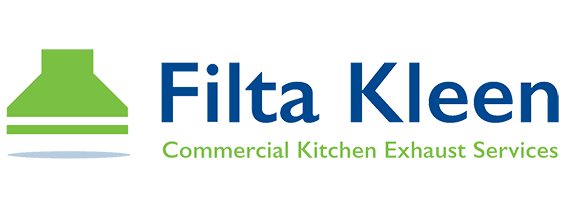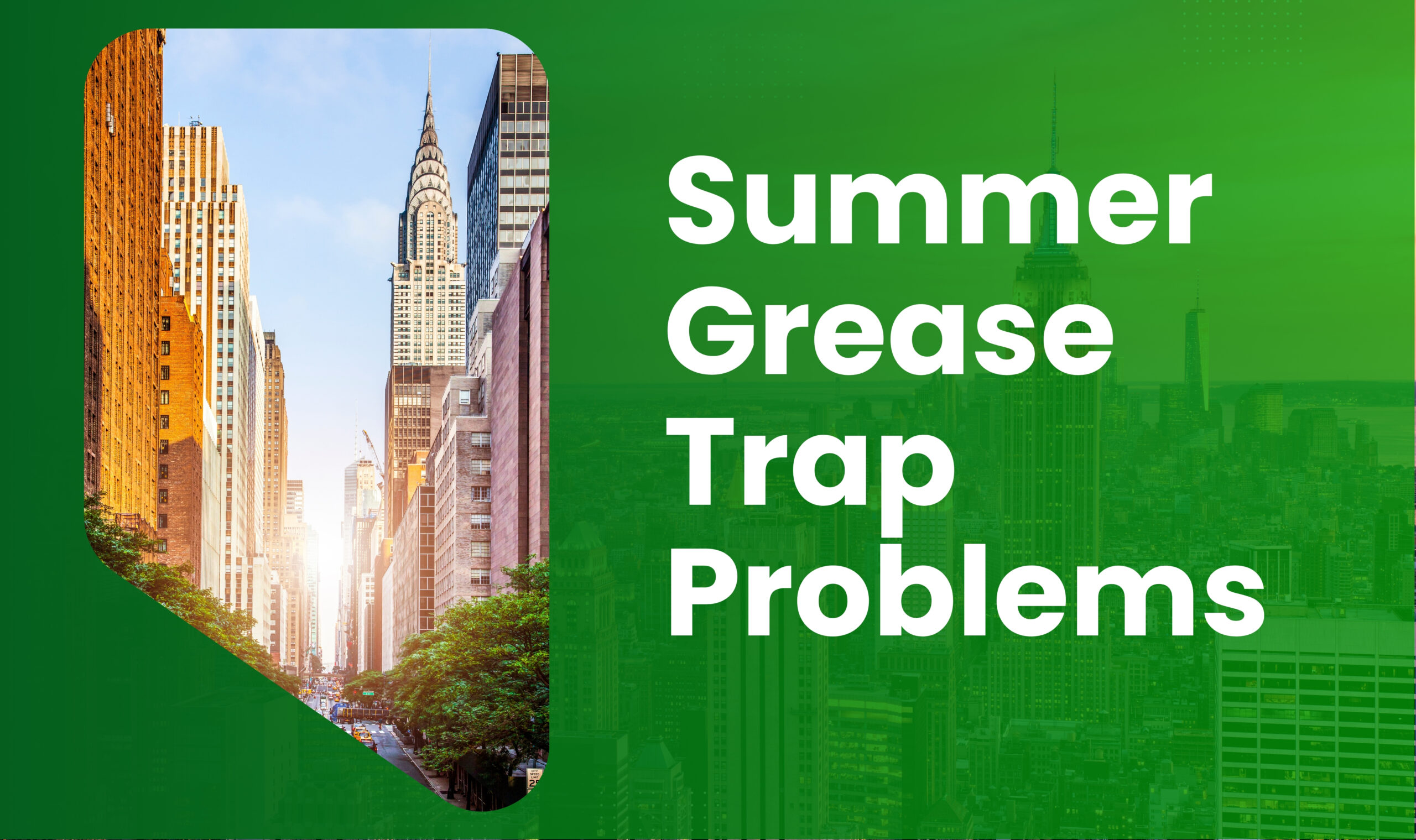The Summer Surge: Why Grease Traps Get Overwhelmed
Summer grease trap problems are more common than most restaurant owners realize. In cities like New York and dense regions of North Jersey, kitchens don’t just get busier in the summer—they run hotter, longer, and harder. Outdoor dining, increased tourist traffic, and seasonal events all push commercial kitchens into overdrive.
Grease traps feel it.
Higher Temperatures Mean Faster Breakdowns
When temperatures climb, grease in the trap breaks down more quickly. That means thicker scum layers, more odor, and a much faster accumulation of sludge. Add in the effect of NYC humidity, and you’re dealing with a perfect storm of accelerated bacterial growth and fermentation. The result? Blockages form sooner. Backups happen faster. And the complaints roll in.
Volume Spikes Add Pressure
Summer in the metro area is peak season for many food service operations. Even kitchens that don’t usually require short-cycle maintenance find themselves caught off guard. Grease traps fill sooner. Systems that might have handled a 90-day cycle in spring now need servicing at 45 or 60.
In some parts of Brooklyn and Queens, local DEP officials have reported an uptick in complaints related to outdoor odors, likely tied to overloaded traps and infrequent pickups. Establishments with limited indoor space often rely on outdoor grease bins, which heat up in the sun and intensify the issue.
What could happen if you ignore the signals? That can set the stage for some serious health and compliance problems.
What Happens When a Grease Trap Fails
When a grease trap fails, it rarely goes unnoticed. Slow drainage turns into standing water. Unpleasant smells drift out into dining areas or neighboring businesses. In some cases, the trap overflows entirely, pushing wastewater and grease into kitchens or surrounding outdoor spaces.
“Improper disposal of fats, oils, and grease (FOG) can cause blockages in sewer systems, leading to costly backups and environmental damage.”
— U.S. Environmental Protection Agency
https://www.epa.gov/npdes/understanding-problem-fats-oils-and-grease-fog
Operational Disruption Comes First
The first sign is usually a backup. Sinks stop draining, dishwashing slows down, and the entire flow of the kitchen gets disrupted. During peak summer service, this kind of interruption isn’t just inconvenient. It causes real financial damage. Tables sit unturned. Food prep halts. Staff improvises workarounds that add risk.
Violations Aren’t Far Behind
Health inspectors in NYC and North Jersey don’t take long to notice signs of grease-related issues. Strong odors, visible overflow, or evidence of drainage issues can lead to immediate citations. Many of these are tied directly to DEP grease regulations and wastewater standards.
Repeated violations put operating licenses at risk. Even a first-time offense can mean fines, follow-up inspections, and added scrutiny from city agencies. In dense neighborhoods, a single complaint from a nearby business or residential tenant can trigger enforcement activity.
Environmental and Public Impact
Overflowing or poorly maintained traps contribute to sewer blockages and storm drain pollution. That makes them a priority for municipal agencies during the summer months, especially after heavy rains. It’s not just a kitchen issue. It’s a community one.
Restaurants dealing with these problems quickly learn that reactive maintenance is the most expensive kind.
“Grease traps that are not cleaned regularly can overflow, resulting in the discharge of grease into the sewer system, which is a violation of NYC DEP regulations.”
— NYC Department of Environmental Protection
https://www.nyc.gov/assets/dep/downloads/pdf/environment/education/education-resources/fats-oils-grease.pdf
The Hidden Cost of Deferred Maintenance
Skipping grease trap service in the summer might seem harmless at first. There’s always a reason to put it off—tight margins, a packed schedule, or the assumption that last quarter’s cleaning was “good enough.” But short-term savings almost always lead to long-term losses.
Emergency Response is Expensive
When a trap backs up, service becomes reactive. Emergency cleanouts cost more, often require after-hours fees, and put added strain on staff already stretched thin. The disruption isn’t limited to plumbing. It often forces partial shutdowns or delayed food service, both of which hit revenue directly.
A single emergency call-out in peak summer can cost more than a full season of scheduled maintenance. And in areas like Manhattan or Hoboken, where access and parking are complicated, those costs multiply fast.
Fines and Re-Inspections Add Up
Municipal violations tied to grease-related blockages or odors carry real financial penalties. DEP inspectors don’t just issue fines. They require proof of remediation. That often includes documentation of service, follow-up inspections, and in some cases, engineering reports if infrastructure was affected.
A missed maintenance cycle can spiral into thousands in direct and indirect costs. When enforcement ramps up in warm-weather months, deferred service becomes a gamble few operators can afford.
Long-Term Damage to Systems
Excess buildup stresses piping, corrodes internal trap surfaces, and contributes to recurring clogs. In older kitchens, these issues become chronic. And replacing a degraded grease trap or affected piping can run well into five figures.
Maintenance isn’t just about avoiding violations. It’s about preserving infrastructure that’s costly to repair and nearly impossible to work around during a busy summer service week.
What NYC Restaurants Should Be Doing Right Now
Preparation matters more than response. Restaurants that build grease management into their summer routine avoid most of the stress that comes from emergency calls and compliance surprises.
“Restaurant owners must take responsibility for managing their grease waste to protect local infrastructure and comply with wastewater ordinances.”
— New Jersey Department of Environmental Protection
https://www.nj.gov/dep/dwq/pdf/fog_programs.pdf
Adjusting for the Season
Summer requires a different service cadence. For most kitchens in NYC and North Jersey, that means moving to more frequent cleanings. What worked in March won’t hold up in July. A service schedule should reflect volume, temperature, and the trap’s historical performance.
Operators should review cleaning logs from last summer and adjust accordingly. If backups started after 75 days, consider moving to 45-day intervals. In high-turnover kitchens, even 30-day cleanings may make sense.
Watch for Warning Signs of Summer Grease Trap Problems
There are always signals. Slow drainage, stronger odors near sinks or floor drains, visible grease buildup around access points—none of these should be ignored. Outdoor bins with visible leaks or pooling residue are red flags, especially when local temperatures hover near 90.
When staff report repeated drain slowdowns, it’s usually not a plumbing issue. It’s a grease trap nearing failure.
Choose a Provider That Knows the Region
Service matters, but local context does too. A provider that understands DEP grease compliance requirements, local enforcement patterns, and logistical quirks like building access or sidewalk discharge regulations will solve problems before they start.
Internal coordination is part of the solution. Teams that handle grease trap cleaning, waste oil pickup, and maintenance as an integrated service help kitchens stay ahead. Establishments that use separate vendors for each task often find themselves caught between delays and finger-pointing.
For restaurants in Brooklyn, the Bronx, or dense parts of Jersey City, response time and route planning are just as critical as the service itself.
Long-Term Strategies for Grease Management
Short-term fixes don’t hold up in a system that runs year-round. Kitchens that take a long view on grease trap service end up spending less, staying compliant, and avoiding last-minute chaos during peak seasons.
Standardizing a Service Calendar
Instead of waiting for issues to appear, many operations now rely on scheduled cleanings that follow a fixed calendar. This reduces uncertainty, builds accountability, and gives managers one less thing to monitor. Cleanings are planned around projected traffic, not reactionary calls.
Incorporating service into monthly or quarterly operations budgets helps avoid the sticker shock of emergency cleanouts. It also makes it easier to align with wastewater compliance guidelines.
Using Data to Drive Frequency
Many providers now offer post-service reports with volume data, grease depth, and condition notes. Tracking this over time helps predict how often service is actually needed. A kitchen may assume it needs 90-day intervals, but the data might show traps fill up at 60. Or vice versa.
That kind of insight allows for optimization—more frequent service in high months, less in slower periods. It also creates a paper trail that’s useful if DEP or another agency requests documentation.
Evaluating System Design
In some cases, repeated issues aren’t about cleaning frequency. They’re about system design. Undersized traps, poorly located access points, or outdated infrastructure can create problems that no cleaning schedule can fix.
Restaurants seeing recurring issues should consider having their systems evaluated. Redesigning a grease trap layout or upgrading to more efficient equipment might seem costly, but it pays off quickly in avoided violations and smoother operations.
Smart grease trap management isn’t seasonal. It’s systemic.
Summer Grease Trap Problems – Act Before It Overflows
Warm weather is the worst time to find out a grease trap has failed. Between the risk of overflow, the uptick in health inspections, and the increased stress on kitchen infrastructure, waiting too long rarely ends well.
Summer doesn’t have to be a scramble. The right plan, built around predictable service and informed by last season’s performance, can keep operations moving smoothly.
Many restaurants that struggled with summer grease trap problems and compliance in the past found stability by locking into a consistent service schedule and working with a provider that handles both cleaning and waste oil removal. When both systems are managed together, it’s easier to stay ahead of issues that impact compliance and public perception.
For those looking to understand service options, maintenance cycles, or regulatory requirements, this resource offers a breakdown of what regular grease trap service includes:
https://filtakleenco.com/grease-trap-waste-oil-pick-up/
Getting ahead of summer grease trap problems doesn’t require guessing. It just requires action before they start.
To learn more read our comprehensive guide to Grease Trap Cleaning in New York City.
FAQ: Summer Grease Trap Problems
What causes more grease trap problems in the summer?
Higher temperatures, increased kitchen activity, and humidity all contribute. Heat accelerates the breakdown of grease and food waste, leading to faster buildup, stronger odors, and more frequent blockages.
How often should grease traps be cleaned during the summer?
It depends on kitchen volume and trap size, but many restaurants in NYC and North Jersey shift from 90-day intervals to 30- to 60-day cycles during the summer months. Reviewing historical service data helps set the right schedule.
What are the signs a grease trap is failing?
Common signs include slow drainage, foul odors, backups at sinks or floor drains, and visible grease around trap access points or outdoor bins. Any of these should prompt immediate service.
Can summer grease trap problems lead to health code violations?
Yes. Overflowing traps or strong odors are often flagged during inspections. These can lead to fines, re-inspections, and in some cases, temporary shutdowns. Local DEP regulations in NYC and New Jersey make compliance a high priority.
Is it more expensive to wait until there’s a problem?
Definitely. Emergency service calls, fines, operational downtime, and potential equipment damage all carry higher costs than scheduled maintenance. Preventive service is almost always the more cost-effective choice.
What else should restaurants do to stay compliant?
Operators should track service dates, document cleanings, monitor grease levels between visits, and coordinate waste oil removal with trap cleanings. Regularly evaluating system design can also prevent recurring issues.
Where can I learn more about proper grease trap service?
A detailed overview of grease trap maintenance, waste oil pickup, and compliance considerations can be found at:
https://filtakleenco.com/grease-trap-waste-oil-pick-up/
✅ Additional Resources
NYC Department of Environmental Protection – Grease Management Requirements
Covers city-specific rules for grease trap installation, maintenance, and enforcement. Ideal for readers concerned with DEP compliance.
🔗 https://www.nyc.gov/assets/dep/downloads/pdf/environment/education/education-resources/fats-oils-grease.pdf
New Jersey Department of Environmental Protection – FOG Control Programs
Details best practices and regulatory requirements across NJ municipalities, applicable to restaurants and commercial kitchens.
🔗 https://www.nj.gov/dep/dwq/pdf/fog_programs.pdf
EPA – Understanding the Problem with Fats, Oils, and Grease (FOG)
Provides a national overview of the public health and infrastructure challenges caused by improper grease disposal.
🔗 https://www.epa.gov/npdes/understanding-problem-fats-oils-and-grease-fog


